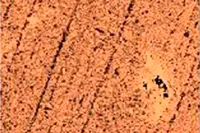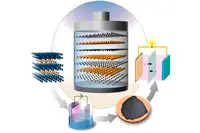Electronics News
Archive : 18 March 2015 год
 Microsemi is acquiring Vitesse Semiconductor in a cash deal for $389million.
Microsemi is acquiring Vitesse Semiconductor in a cash deal for $389million.
"This acquisition is further evidence of Microsemi's continuing commitment to grow as a communications semiconductor company," said James Peterson, Microsemi's chairman and CEO. "Vitesse's highly complementary technology suite will expand our product offering and accelerate growth with differentiated technology in emerging markets, while benefitting from the increased scale, consolidated infrastructure and cost savings of the combined entity."
Vitesse is a fabless developer of communications technology, with a focus on Ethernet devices for carrier, enterprise and IoT applications.
Chris Gardner, Vitesse's CEO, added: "I believe Microsemi will be able to leverage Vitesse's Ethernet technology and capabilities further into the communications market and has the scale to implement the adoption of our industrial IoT strategy."
Author
Graham Pitcher
Source: www.newelectronics.co.uk
 A process developed by researchers at Caltech in the US could enable the production of large areas of graphene at low temperatures and more quickly.
A process developed by researchers at Caltech in the US could enable the production of large areas of graphene at low temperatures and more quickly.
"Previously, people were only able to grow a few square millimetres of high mobility graphene at a time and it required very high temperatures, long periods of time and many steps," said Professor Nai-Chang Yeh. "Our new method can consistently produce high mobility and nearly strain-free graphene in a single step in just a few minutes without high temperature. We have created sample sizes of a few square centimetres and, since we think that our method is scalable, we believe that we can grow sheets that are up to several square inches or larger, paving the way to realistic large scale applications."
The process uses a hydrogen plasma to clean the surface of a sheet of copper, after which the introduction of methane starts the growth of graphene in a more orderly way than the high temperature approaches used previously.
The ability to produce graphene without the need for active heating not only reduces manufacturing costs, but also results in a better product because fewer defects are generated. "Typically, it takes about 10 hours and nine to ten different steps to make a batch of high mobility graphene using high temperature growth methods," Prof Yeh noted. "Our process involves one step and it takes five minutes."
Further investigations have shown that graphene made using the new technique is of higher quality, is stronger and it has the highest electrical mobility yet measured for synthetic graphene.
A scaled up version of the plasma technique could open the door for new kinds of electronics manufacturing, Prof Yeh said. "In the future, you could have graphene based mobile phone displays that generate their own power."
Author
Graham Pitcher
Source: www.newelectronics.co.uk
 The Heterogeneous System Architecture (HSA) Foundation has released version 1.0 of the HSA specification, a move which it says brings the industry 'one step closer' to true heterogeneous computing on a range of platforms.
The Heterogeneous System Architecture (HSA) Foundation has released version 1.0 of the HSA specification, a move which it says brings the industry 'one step closer' to true heterogeneous computing on a range of platforms.
HSA, a standardised platform design supported by more than 40 companies and 17 universities, is said to unlock the performance and power efficiency of parallel computing engines. It allows developers to apply the hardware resources in complex SoCs efficiently.
"Through HSA, we are working to ensure that end users of technology live in a world of new, incredible applications that run fast at low power," said HSA Foundation president Phil Rogers. "The members have been collaborating on this project since June 2012 and we are thrilled to be delivering the fruit of that labour."
The specification comprises a number of elements that improve the programmability of heterogeneous processors, the portability of programming code and interoperability across different vendor devices. These include:
the HSA System Architecture Specification, which defines how the hardware operates;
the HSA Programmers Reference Manual, which targets the software ecosystem, tool and compiler developers; and
the HSA Runtime Specification, which defines how applications interact with HSA platforms.
Jem Davies, vp of technology with ARM's media processing group, added: "Heterogeneous computing is playing an increasing role in system design. HSA systems will enable energy efficient interoperation between multiple processor types to take full advantage of next generation SoCs."
Author
Graham Pitcher
Source: www.newelectronics.co.uk
 A high performance cathode material developed by researchers from Drexel University in the US, in association with Aix-Marseille University, is said to have great promise for use in next generation lithium-sulphur batteries.
A high performance cathode material developed by researchers from Drexel University in the US, in association with Aix-Marseille University, is said to have great promise for use in next generation lithium-sulphur batteries.
A high performance cathode material developed by researchers from Drexel University in the US, in association with Aix-Marseille University, is said to have great promise for use in next generation lithium-sulphur batteries.
While lithium-sulphur batteries have higher energy density than lithium-ion, one of the challenges for the technology is to find cathode materials that demonstrate long term stability.
Looking to address the issue, Dr Yury Gogotsi from Drexel has created a two dimensional carbon/sulphur nanolaminate that could be a candidate cathode. The team did so by extracting the nanolaminate from a material called a Ti2SC MAX phase – one of a family of layered ceramics.
According to the team, carbon/sulphur nanolaminates have covalent bonding between carbon and sulphur and an extremely uniform distribution of sulphur between atomically thin carbon layers.
The nanolaminates synthesised by Dr Gogotsi's group are said to demonstrate the same uniformity as infiltrated carbon nanomaterials, but the sulphur in the nanolaminates is deposited uniformly in the carbon matrix as atomically thin layers. This, says the team, may have a significant impact on increasing the life span of next generation batteries.
"We have enough evidence to show that electrochemical etching can be a powerful method to selectively extract the M elements from the MAX phases, to produce a variety of AX layered structures that cannot be made otherwise," said Meng-Qiang Zhao, Dr Gogotsi's post doctoral associate.
"It is not difficult to foresee that the AX structures represent a new family of nanostructured materials, much of which will probably be 2D," Dr Gogotsi said. "The various A and X combinations already known make AX structures attractive for a number of potential applications, such as electrical energy storage and catalysis."
Author
Graham Pitcher
Source: www.newelectronics.co.uk

